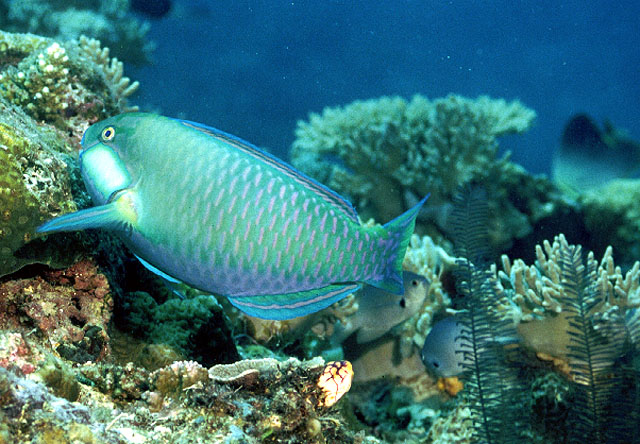| Scaridae (Parrotfishes), subfamily: Scarinae |
| 49 cm TL (male/unsexed) |
|
reef-associated; marine; depth range 0 - 35 m |
| Indo-Pacific: East Indian region to Micronesia, Samoa, and Fiji and Philippines to Australia; throughout East Indian region except Andaman Sea. |
|
Dorsal spines (total): 9-9; Dorsal soft rays (total): 10-10; Anal spines: 3-3; Anal soft rays: 9-9. This species is distinguished by the following characters: median predorsal scales 5-7 (usually 6); 2 scale rows on cheek, 1(6-8), 2(6-8); pectoral-fin rays 15; dental plates well exposed, lips not covering the plates; 1-2 conical teeth on side of upper dental plate; caudal fin truncate. Colour of initial phase (IP) dark brown with broad pale bars on sides and pale caudal fin and caudal peduncle; male with greenish large pale cream patch below eye bordered entirely by a thick green line. Male greenish with pink scale edges, green central zone and outer margins on tail and large rectangular whitish area on cheek; female dark brown with 3-4 broad pale bars (Ref. 9793, 90102, 117228). |
| Found in clear coastal and inner reefs (Ref. 48636); in lagoons and channel reefs (Ref. 2334). Feeds by scraping algae from the substrate (Ref. 26993). Females usually in small groups and maybe mixed with other species when feeding; males solitary nearby (Ref. 48636). Minimum depth reported taken from Ref. 128797. |
|
Least Concern (LC); Date assessed: 15 September 2009 Ref. (130435)
|
| harmless |
Source and more info: www.fishbase.org. For personal, classroom, and other internal use only. Not for publication.

